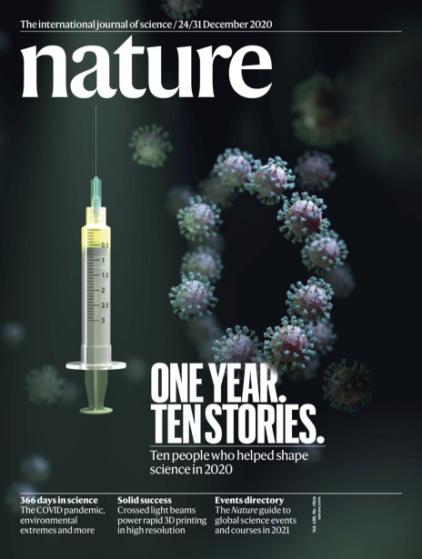原标题:《自然》(20201224出版)一周论文导读
【本文来自微信公众号“科学网”】
翻译 | 李言
Science, 24 December 2020, Volume 588 Issue 7839
《科学》2020年12月24日,第588卷,7839期

环境科学Environmental Sciences
Maximizing US nitrate removal through wetland protection and restoration
通过保护和恢复湿地来最大程度地去除硝酸盐
▲ 作者:F. Y. Cheng, K. J. Van Meter, D. K. Byrnes & N. B. Basu
▲ 链接:
https://www.nature.com/articles/s41586-020-03042-5
▲ 摘要
人口增长和农业集约化导致了河流氮负荷的增加,沿海地区广泛的河流氮含量和藻华发生率的增加。
本文利用国家湿地调查数据和5公里网格尺度的氮输入和输出估计表明,美国湿地当前的氮减少(约860±160千吨氮/年)受到高密度湿地和氮热点之间的空间脱节的限制。
我们的模型表明,美国湿地面积的空间目标增加10%(510万公顷)将使湿地氮的去除量增加一倍。这一增长将使诸如密西西比河流域等受硝酸盐影响的流域的氮负荷估计减少54%。
▲ Abstract
Growing populations and agricultural intensification have led to raised riverine nitrogen (N) loads, widespread oxygen depletion in coastal zones (coastal hypoxia) and increases in the incidence of algal blooms. Here we use National Wetland Inventory data and 5-kilometre grid-scale estimates of N inputs and outputs to demonstrate that current N removal by US wetlands (about 860 ± 160 kilotonnes of nitrogen per year) is limited by a spatial disconnect between high-density wetland areas and N hotspots. Our model simulations suggest that a spatially targeted increase in US wetland area by 10 per cent (5.1 million hectares) would double wetland N removal. This increase would provide an estimated 54 per cent decrease in N loading in nitrate-affected watersheds such as the Mississippi River Basin.
材料科学Material Science
Xolography for linear volumetric 3D printing
X线照相体积光固化3D打印技术
▲ 作者:Martin Regehly, Yves Garmshausen, Marcus Reuter, Niklas F. König, et al.
▲ 链接:
https://www.nature.com/articles/s41586-020-3029-7
▲ 摘要
增材制造的应用范围正在迅速扩大,包括运动鞋部件、牙科陶瓷和航空航天部件的大规模生产,以及微流体、医疗设备和人工器官的制造。立体3D打印是连续增材制造方法的下一步。
在此,我们向大家介绍X线照相体积3D打印,一种使用可以光转换的光引发剂,通过相交不同波长的光束进行线性激发,诱导特定的单体体积内局部聚合的双光技术。
我们用一台体积打印机演示了这一概念,该打印机可以生成具有复杂结构特征以及机械和光学功能的三维物体。与最先进的体积打印方法相比,该技术的分辨率约为无反馈优化的计算轴向光刻的10倍,体积产生速率比双光子光聚合3D打印技术高4 - 5个数量级。
▲ Abstract
The range of applications for additive manufacturing is expanding quickly, including mass production of athletic footwear parts, dental ceramics and aerospace components as well as fabrication of microfluidics, medical devices, and artificial organs. Volumetric 3D printing is the next step onward from sequential additive manufacturing methods. Here we introduce xolography, a dual colour technique using photoswitchable photoinitiators to induce local polymerization inside a confined monomer volume upon linear excitation by intersecting light beams of different wavelengths. We demonstrate this concept with a volumetric printer designed to generate three-dimensional objects with complex structural features as well as mechanical and optical functions. Compared to state-of-the-art volumetric printing methods, our technique has a resolution about ten times higher than computed axial lithography without feedback optimization, and a volume generation rate four to five orders of magnitude higher than two-photon photopolymerization.
Strongly correlated Chern insulators in magic-angle twisted bilayer graphene
魔角扭曲双层石墨烯中的强相关Chern绝缘子
▲ 作者:Kevin P. Nuckolls, Myungchul Oh, Dillon Wong, Biao Lian, Kenji Watanabe
▲ 链接:
https://www.nature.com/articles/s41586-020-3028-8
▲ 摘要
在魔角扭曲双层石墨烯(MATBG)中发现具有拓扑特征的扁平电子带,为寻找强相关的拓扑相创造契机。
在此,我们过扫描隧道电子显微镜中引入局部光谱表征技术,发现在MATBG材料中Chern number为C=±1, ±2, ±3时,分别在单位晶格中形成填充因子为±3, ±2, ±1表现的一系列拓扑绝缘态,并且这种拓扑相通过强度适中的磁场稳定。
这里检测到的一个相(C = +1)是此前观察到的,当六方氮化硼衬底故意打破MATBG的亚晶格对称性时,相互作用具有次要作用。我们证明,仅强的电子-电子相互作用不仅可以产生先前观察到的相,而且还可以在MATBG中产生未预料的Chern绝缘相。
▲ Abstract
The discovery of flat electronic bands with topological character in magic-angle twisted bilayer graphene (MATBG) has created a unique opportunity to search for strongly correlated topological phases. Here we introduce a local spectroscopic technique using a scanning tunnelling microscope to detect a sequence of topological insulators in MATBG with Chern numbers C = ±1, ±2 and ±3, which form near filling factors of ±3, ±2 and ±1 electrons per moiré unit cell, respectively, and are stabilized by modest magnetic fields. One of the phases detected here (C = +1) was previously observed when the sublattice symmetry of MATBG was intentionally broken by a hexagonal boron nitride substrate, with interactions having a secondary role. We demonstrate that strong electron–electron interactions alone can produce not only the previously observed phase, but also other unexpected Chern insulating phases in MATBG.
物理学Physics
Plasmonic topological quasiparticle on the nanometre and femtosecond scales
纳米级和飞秒级的等离子拓扑准粒子
▲ 作者:Yanan Dai, Zhikang Zhou, Atreyie Ghosh, Roger S. K. Mong, et al.
▲ 链接:
https://www.nature.com/articles/s41586-020-3030-1
▲ 摘要
在经典物理学和量子物理学的层面,麦克斯韦和薛定谔方程描述了光场如何驱动和控制电子现象,以使光波电子在太赫兹或千赫频率和超小尺度成为可能。撞击金属的光电场与电子相互作用,在一秒的时间尺度上产生光物质准粒子,如激子或等离子体激子。
在此,我们在结构银膜中创建并成像一个具有拓扑等离子体自旋结构的准粒子。这些自旋织构位于光的半波长范围内,并且存在于等离子体场的时间尺度上。
我们使用超快非线性相干光电子显微镜生成了涡旋场空间演化的阿秒影像;电磁模拟和解析理论证实了等离子体梅隆准粒子的存在。准粒子形成手性场,在纳米空间尺度和20飞秒(纳米飞秒尺度)上打破了时间反转的对称性。
▲ Abstract
At the interface of classical and quantum physics, the Maxwell and Schrödinger equations describe how optical fields drive and control electronic phenomena to enable lightwave electronics at terahertz or petahertz frequencies and on ultrasmall scales. The electric field of light striking a metal interacts with electrons and generates light–matter quasiparticles, such as excitons or plasmons, on an attosecond timescale. Here we create and image a quasiparticle of topological plasmonic spin texture in a structured silver film. These spin textures are localized within a half-wavelength of light, and exist on the timescale of the plasmonic field. We use ultrafast nonlinear coherent photoelectron microscopy to generate attosecond videos of the spatial evolution of the vortex fields; electromagnetic simulations and analytic theory confirm the presence of plasmonic meron quasiparticles. The quasiparticles form a chiral field, which breaks the time-reversal symmetry on a nanometre spatial scale and a 20-femtosecond timescale (the ‘nano-femto scale’).
Superconducting qubit to optical photon transduction
超导量子位到光子的转换
▲ 作者:Mohammad Mirhosseini, Alp Sipahigil, Mahmoud Kalaee & Oskar Painter
▲ 链接:
https://www.nature.com/articles/s41586-020-3038-6
▲ 摘要
光电信号的转换是全球互联网的基础。这种转换器用于扩大长途光纤通信系统的范围,并用于数据中心内计算机的高速光网络。尽管量子网络前景广阔,但仍未实现利用超导量子位元在这种转换过程中维持脆弱的量子态。
在此,我们演示了超导量子位跨频激发到光子的微波频率的转换。
我们利用一个中间的纳米机械谐振器,通过压电相互作用将量子比特的电激励转化为单个声子,然后通过辐射压力将声子转化为光子。我们通过在光纤上探测发射光的单光子来记录量子位元的量子拉比振荡,从而证明从量子位元产生光子的过程。
▲ Abstract
Conversion of electrical and optical signals lies at the foundation of the global internet. Such converters are used to extend the reach of long-haul fibre-optic communication systems and within data centres for high-speed optical networking of computers. Despite the prospects of quantum networking, maintaining the fragile quantum state in such a conversion process with superconducting qubits has not yet been achieved. Here we demonstrate the conversion of a microwave-frequency excitation of a transmon—a type of superconducting qubit—into an optical photon. We achieve this by using an intermediary nanomechanical resonator that converts the electrical excitation of the qubit into a single phonon by means of a piezoelectric interaction and subsequently converts the phonon to an optical photon by means of radiation pressure. We demonstrate optical photon generation from the qubit by recording quantum Rabi oscillations of the qubit through single-photon detection of the emitted light over an optical fibre.
人工智能Artificial Intelligence
Mastering Atari, Go, chess and shogi by planning with a learned model
建立学习模型掌握Atari游戏、围棋、国际象棋和将棋
▲ 作者:Julian Schrittwieser, Ioannis Antonoglou, Thomas Hubert, Karen Simonyan, et al.
▲ 链接:
https://www.nature.com/articles/s41586-020-03051-4
▲ 摘要
构建具有规划能力的智能体一直是人工智能研究的主要挑战之一。然而,在现实问题中,控制环境的动态往往是复杂和未知的。
在此,我们提出MuZero算法。该算法通过将基于树的搜索与一个学习模型相结合,在一系列具有挑战性和视觉上复杂的领域中实现了超人的性能,而不需要了解它们的底层动力学。
MuZero算法学习一个可迭代的模型,该模型产生与计划相关的预测:行动选择策略、价值函数和奖励。我们在57个不同的Atari游戏上进行评估时,MuZero算法实现了最先进的性能。
▲ Abstract
Constructing agents with planning capabilities has long been one of the main challenges in the pursuit of artificial intelligence. However, in real-world problems, the dynamics governing the environment are often complex and unknown. Here we present the MuZero algorithm, which, by combining a tree-based search with a learned model, achieves superhuman performance in a range of challenging and visually complex domains, without any knowledge of their underlying dynamics. The MuZero algorithm learns an iterable model that produces predictions relevant to planning: the action-selection policy, the value function and the reward. When evaluated on 57 different Atari games—the canonical video game environment for testing artificial intelligence techniques, in which model-based planning approaches have historically struggled—the MuZero algorithm achieved state-of-the-art performance.
编辑|宗华

4000520066 欢迎批评指正
All Rights Reserved 新浪公司 版权所有

